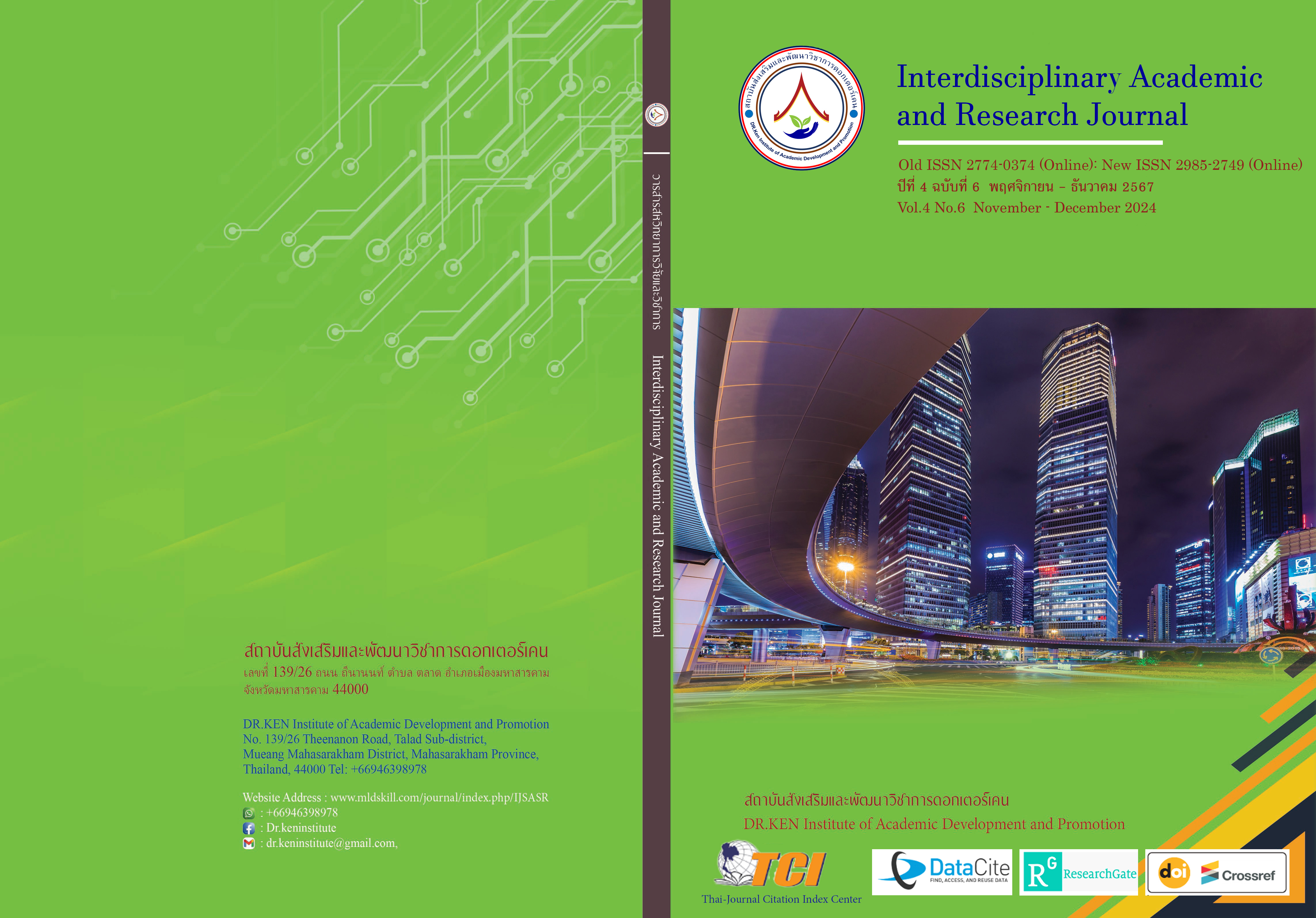Creative Leadership of Educational Institution Administrators in the Digital Era of Educational Institutions under the Nakhon Ratchasima Primary Educational Service Area Office 3
DOI:
https://doi.org/10.60027/iarj.2024.278094Keywords:
Leadership orientation; , Technological leader;, Educational institution administrators in Digital AgeAbstract
Background and Aims: In the era of globalization where technology is developing rapidly. Educational institution administrators need to use technology and innovation in management to increase efficiency and results of educational institutions. Therefore, technological leadership is an important skill that executives should have. This research aims to (1) study the technological leadership of school administrators in the digital era in Nakhon Ratchasima Primary Educational Service Area Office 3. (2) compare the technological leadership of administrators according to age, position, and work experience. (3) Study guidelines for developing executives' technological leadership. This research includes an assessment of the current status. comparison and developing approaches to improve technological leadership. This is important in developing the quality of education in the digital age.
Methodology: The sample for this research consisted of 331 school administrators and teachers who were randomly assigned according to Krejci and Morgan's tables. The research instrument was a 5-level rating scale questionnaire with a consistency index between 0.80 - 1.00 and the reliability of the entire questionnaire was 0.87. Data analysis used statistics: frequency, percentage, mean, and standard deviation. T-value and F-value tests.
Results: The results of the research found that (1) the technological leadership of school administrators in the digital era in Nakhon Ratchasima Primary Educational Service Area 3 was overall at a high level. (2) The results of comparing the technological leadership of executives by position found that there was a statistical significant difference at the .05 level, but when classified by age and work experience, it was found that there was no difference. (3) Guidelines for developing technological leadership for school administrators in the digital era consist of 5 areas: supporting equality and citizenship; Vision planning capacity building system design and continuous learning.
Conclusion: According to the study, school administrators in Nakhon Ratchasima Primary Educational Service Area 3 generally have high levels of technological leadership. In order to improve their technological leadership, they should prioritize developing their vision planning capacity, creating support systems, encouraging continuous learning, and promoting equality.
References
กัญญาภัค จูฑพลกุล และทัศนะ ศรีปัตตา. (2565). ภาวะผู้นําของผู้บริหารสถานศึกษาในยุคดิจิทัลสังกัดสำนักงานเขตพื้นที่การศึกษามัธยมศึกษานครสวรรค์. Journal of Roi Kaensarn Academi. 7(10), 271-284.
เกิดศักดิ์ ศิริมาตยาพันธุ์ และรุจิราพรรณ คงช่วย. (2565). ภาวะผู้นําทางเทคโนโลยีของผู้บริหารสถานศึกษาตามทัศนะของครูสังกัดสำนักงานเขตพื้นที่การศึกษามัธยมศึกษา เขต 13 จังหวัดตรัง. วารสารครุพิบูล. 9(1), 125-135.
จีระศักดิ์ ชุมภู. (2564). การศึกษาภาวะผู้นำเชิงเทคโนโลยีของผู้บริหารสถานศึกษาในกลุ่มสหวิทยาเขตสุดถิ่นไทย จังหวัดเชียงราย. ปริญญาการศึกษามหาบัณฑิต สาขาวิชาการบริหารการศึกษา: มหาวิทยาลัยพะเยา.
เจษฎา ชวนะไพศาล. (2563). แนวทางการพัฒนาภาวะผู้นำเชิงเทคโนโลยีของผู้บริหารสถานศึกษากลุ่มสหวิทยาเขตทวารวดีสังกัดสำนักงานเขตพื้นที่การศึกษามัธยมศึกษาสุพรรณบุรี. วิทยานิพนธ์ปริญญามหาบัณฑิต (การบริหารการศึกษา): มหาวิทยาลัยศิลปากร.
ชัยนาม บุญนิตย์. (2563). ภาวะผู้นำทางเทคโนโลยีและนวัตกรรมของผู้บริหารสถานศึกษาสังกัดสำนักงาน เขตพื้นที่การศึกษาประถมศึกษาสุโขทัย เขต 2. วิทยานิพนธ์ ค.ม. (สาขาวิชาการบริหารการศึกษา): มหาวิทยาลัยราชภัฏอุตรดิตถ์.
นิศาชล บำรุงภักดี. (2563). ความสัมพันธ์ระหว่างภาวะผู้นำทางเทคโนโลยีสารสนเทศของผู้บริหารสถานศึกษากับประสิทธิผลโรงเรียน ในสังกัดองค์กรปกครองส่วนท้องถิ่นจังหวัดสกลนคร. วิทยานิพนธ์ศึกษาศาสตรมหาบัณฑิต (การบริหารการศึกษา): มหาวิทยาลัยราชภัฏสกลนคร.
บุญชม ศรีสะอาด. (2553). การวิจัยเบื้องต้น. พิมพ์ครั้งที่ 8. กรุงเทพฯ: สุวีริยาสาส์น.
พระราชวุธปญฺญาวชิโร (เพชรไพร). (2561). การบริหารสถานศึกษาในยุคดิจิทัล ตามหลักสัปปุริสธรรม 7 โรงเรียนพระปริย์ติธรรม แผนกสามัญศึกษา จังหวัดขอนแก่น. วิทยานิพนธ์ปริญญาพุทธศาสตรมหาบัณฑิต (พุทธบริหารการศึกษา) : มหาวิทยาลัยมหาจุฬาลงกรณราชวิทยาลัย.
รุจาภรณ์ ลักษณะดี. (2565). ภาวะผู้นำการดิจิทัลของผู้บริหารสถานศึกษาในสหวิทยาเขตบ้านบึง 1 สังกัดสำนักงานเขตพื้นที่การศึกษาประถมศึกษาชลบุรี เขต 1. วิทยานิพนธ์ปริญญามหาบัณฑิต, มหาวิทยาลัยเกริก.
ฤทธิกร โยธสิงห์, อัจฉรา นิยมาภา และวิสุทธิ์ วิจิตรพัชราภรณ์. (2565). ภาวะผู้นำดิจิทัลของผู้บริหารสถานศึกษาที่ส่งผลต่อการบริหารงานวิชาการในสถานการณ์ ชีวิตวิถีใหม่ของโรงเรียน สังกัดสำนักงานเขตพื้นที่การศึกษามัธยมศึกษาบุรีรัมย์. วารสารการบริหารการศึกษาและภาวะผู้นำ มหาวิทยาลัยราชภัฏสกลนคร. 10(38), 145-154.
วรรณนภา จำเนียรพืช. (2564). ภาวะผู้นำทางเทคโนโลยีของผู้บริหารสถานศึกษาที่ส่งผลต่อทักษะครูในศตวรรษที่ 21 ของสถานศึกษา สังกัดสำนักงานเขตพื้นที่การศึกษามัธยมศึกษาเขต 3 จังหวัดพระนครศรีอยุธยา. วิทยานิพนธ์ครุศาสตรมหาบัณฑิต: มหาวิทยาลัยราชภัฏพระนครศรีอยุธยา.
สำนักงานเขตพื้นที่การศึกษาประถมศึกษานครราชสีมา. (2566). แผนปฏิบัติการประจำปี 2566. นครราชสีมา: สำนักงานเขตพื้นที่การศึกษาประถมศึกษานครราชสีมา เขต 3.
สุกัญญา แช่มช้อย. (2561). การบริหารสถานศึกษาในยุคดิจิทัล. กรุงเทพมหานคร: โรงพิมพ์แห่งจุฬาลงกรณ์มหาวิทยาลัย.
สุเหด หมัดอะดัม และสุนทรี วรรณไพเราะ. (2562). ภาวะผู้นำเชิงเทคโนโลยีของผู้บริหารสถานศึกษาตามความคิดเห็นของครูโรงเรียนเอกชน สังกัดสำนักงานการศึกษาเอกชนจังหวัดสงขลา. วิทยานิพนธ์การศึกษามหาบัณฑิต: มหาวิทยาลัยทักษิณ.
International Society for Technology in Education (2018). ISTE STANDARDS FOR EDUCATION LEADERS. Retrieved from: https://www.iste.org/standards/foreducationleaders.
Krejcie, R.V., & Morgan, D. W. (1970). Determining sample size for research activities. Educational and Psychological Measurement. 30(3), 607–610.
Downloads
Published
How to Cite
Issue
Section
License
Copyright (c) 2024 Interdisciplinary Academic and Research Journal

This work is licensed under a Creative Commons Attribution-NonCommercial-NoDerivatives 4.0 International License.
Copyright on any article in the Interdisciplinary Academic and Research Journal is retained by the author(s) under the under the Creative Commons Attribution-NonCommercial-NoDerivatives 4.0 International License. Permission to use text, content, images, etc. of publication. Any user to read, download, copy, distribute, print, search, or link to the full texts of articles, crawl them for indexing, pass them as data to software, or use them for any other lawful purpose. But do not use it for commercial use or with the intent to benefit any business.
















.png)


